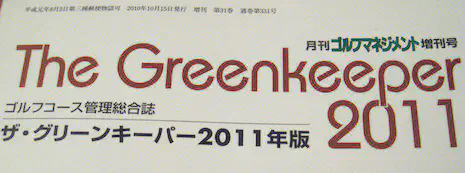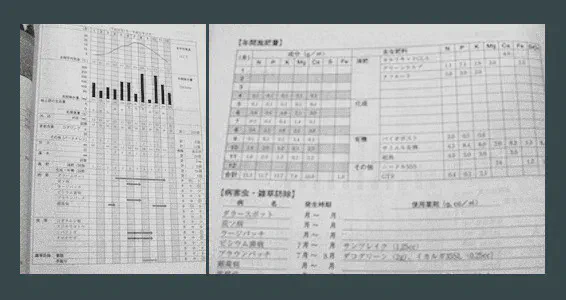Why I Study Japanese
There are two monthly magazines that go to almost every golf course in Japan. One is Golf Course Seminar, published by Golf Digest Japan, for which I write a column about turfgrass science; the other is *Monthly Golf Management, by Ikki Publishing, who also produce the annual Greenkeeper almanac.
The Greenkeeper 2011 has five sections, the first three being reviews of major tournament preparations, what appears to be a turf science quiz, and reviews of some turf science meetings held in Japan during 2010.

It is the final two sections that make up 80% of this 358 page book, and these are the sections that I find the most interesting, and that I can, with my rudimentary Japanese, understand to some extent.
These sections include the fertilizer and pesticide and mowing information (and much, much, more), giving the entire maintenance schedule, really, for 26 golf courses, and then a Golf Course Data File with general information, including grass types down to variety, for 949 courses in Japan.
What specifically do I find most interesting in this book?

The very fact that it is published, that there is a demand for such data, that the publishers go to the effort to compile it and print it, and that so many golf courses share the information.
The huge variations in fertilizer application ratios and timing. Some courses are using less than 10 g N m-2 per year for creeping bentgrass in a growing environment in which I believe 15 g N m-2 is more reasonable. Some have an N-P-K ratio of approximately 8:1:8, which I understand, or 8:1:4, which I think in most situations would be optimum, and some have approximately 8:1:16, which I think is too much K, but I understand that also. Then there are those with approximately 1:1:1 ratios, or 3:4:2 ratios, and then I wonder what those greenkeepers are trying to accomplish by applying so much phosphorus. Or the course applying just over 6 g N m-2 annually, but more than 13 g Mg m-2? Why? Or how about 33 g Ca m-2 and 1 g Mg m-2? That is a 30:1 ratio, but in the grass Ca and Mg will have a nearly 2:1 ratio.
The mowing heights and number of greens mowing events are given by month, and I find it interesting that at a particular course with an unusual fertilizer ratio, the putting greens were mown 31 times in July, 16 times in August, and only 9 times in September. Did the fertilizer applications have anything to do with that? This is voyeuristic, I know, but for a turfgrass scientist who is interested in the practical aspects of turfgrass maintenance, I find it fascinating to have all this information in front of me and it gives me a tremendous number of ideas for information to discuss in training programs or magazine articles or research and advisory projects.
I may be completely missing it, but I see nothing in the course data guides about what the soil pH or nutrient levels are, nor anything about soil organic matter content, nor anything about irrigation water quality. For some reason, these types of data are given much more weight in the United States.
Penncross is the preponderant bentgrass variety growing on putting greens (as of The Greenkeeper 2011). There are 949 facilities listed in Section 5, the Golf Course Data File. This represents nearly half the golf courses in Japan. Of these, 649 have Penncross greens.
The book is fascinating but seems to be lacking something that greenkeepers can actually use to help them improve playing conditions. The book is 358 pages packed full of data about golf course operations, and specifically grass types used and maintenance practices employed, on golf courses in Japan. Yet the information is, to some extent, of little practical use, because it is all passive, just in a book; it is not necessarily correct — writing out the detailed maintenance activities for a course does not necessarily mean it is a correct set of work or one that should be copied; and for a greenkeeper who is managing Penncross, it may be of some solace to know that so many others are also managing the same grass, but it doesn’t change the fact that almost any variety other than Penncross would have better performance in Japan.
Still, it is fascinating, and I look forward to seeing The Greenkeeper when it is published each fall, and it is books such as this that make me wish I knew more Japanese.